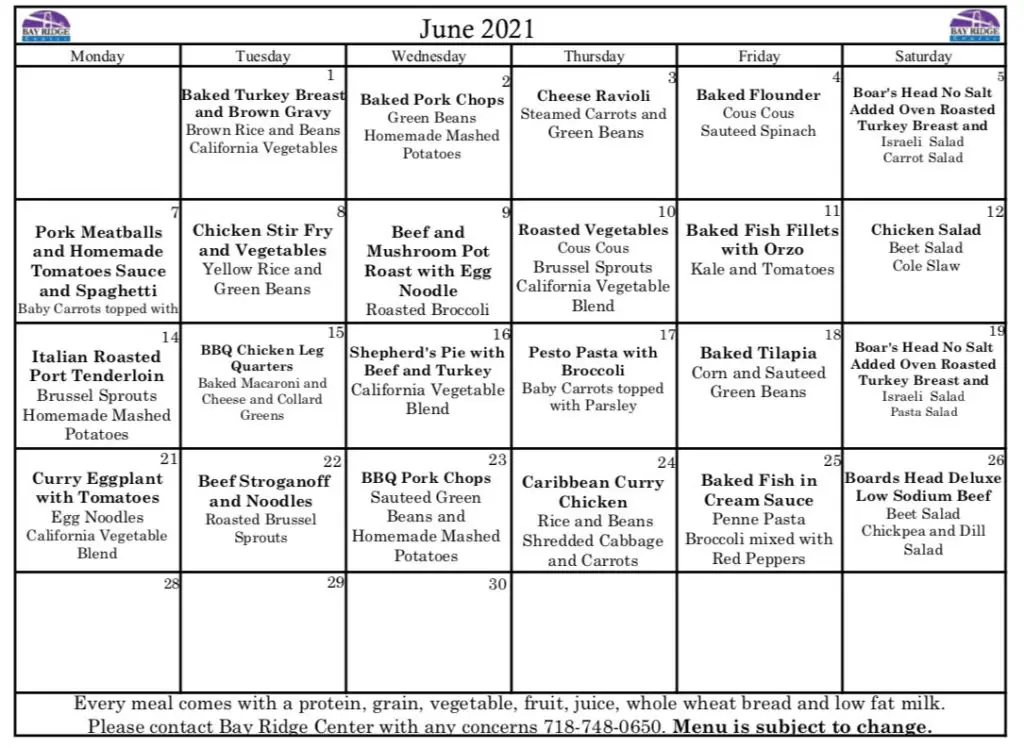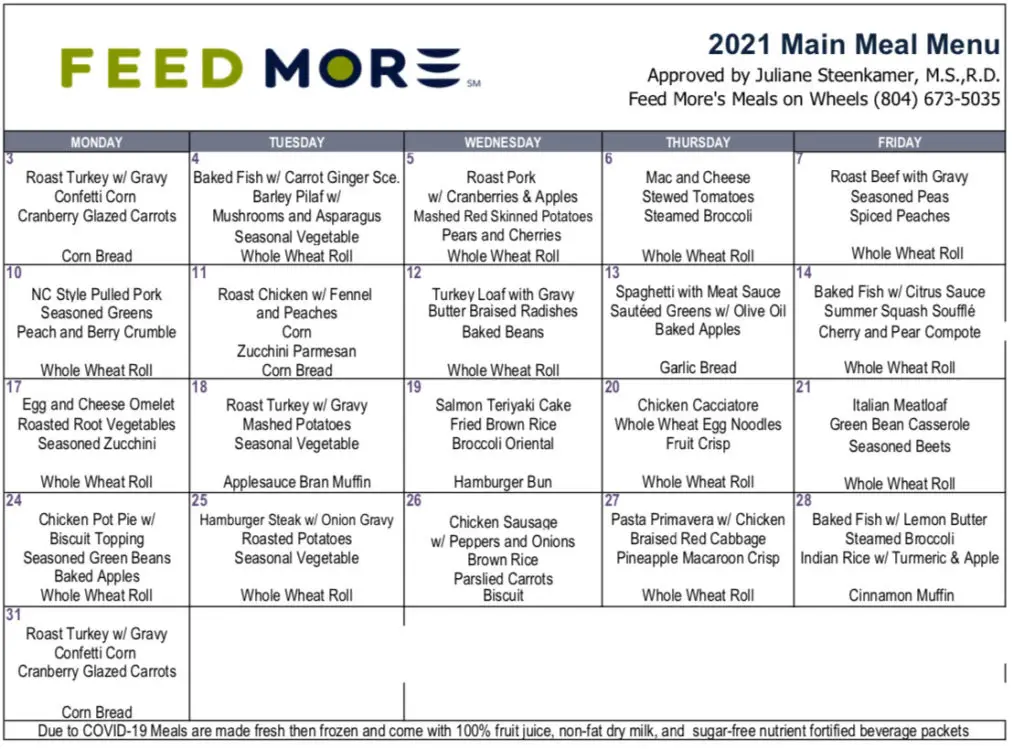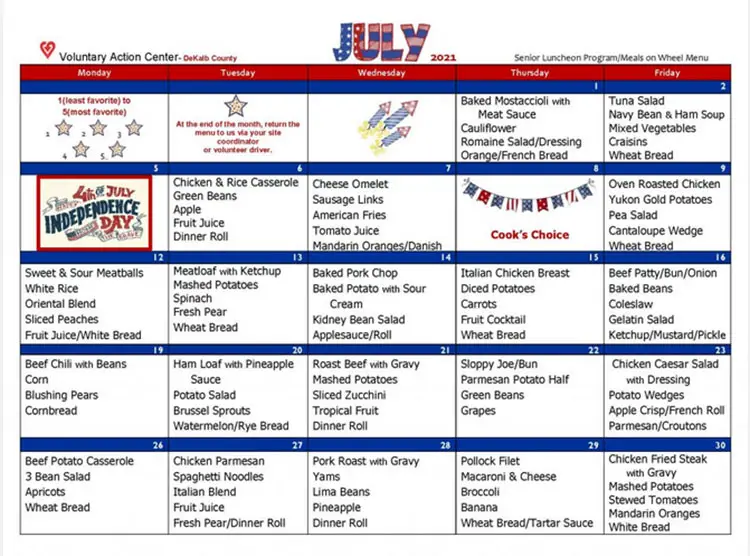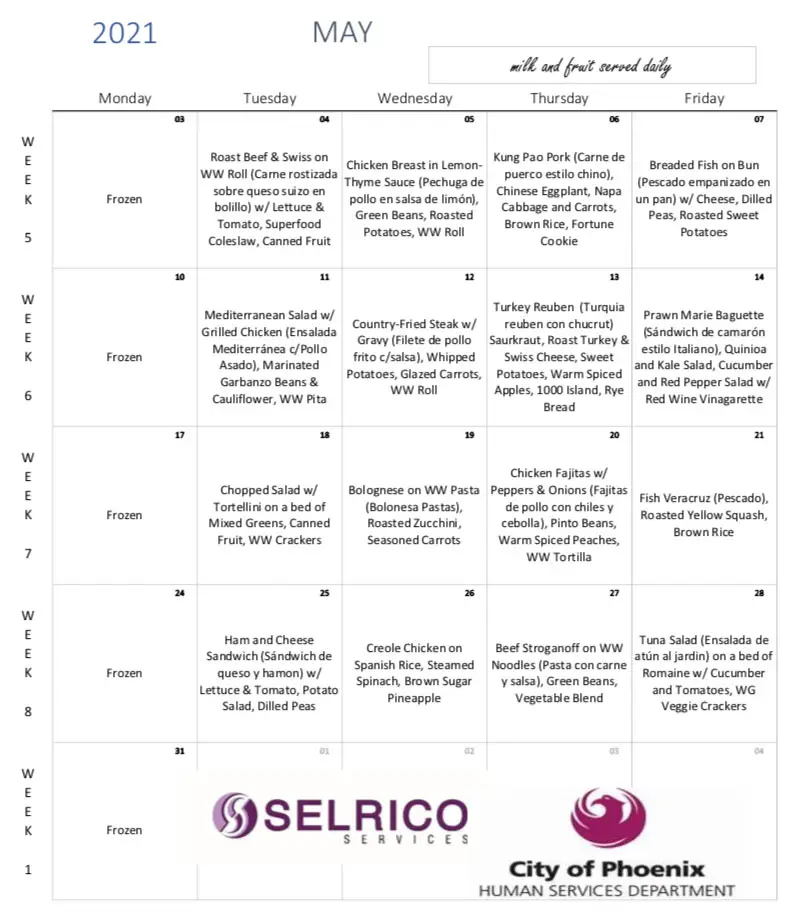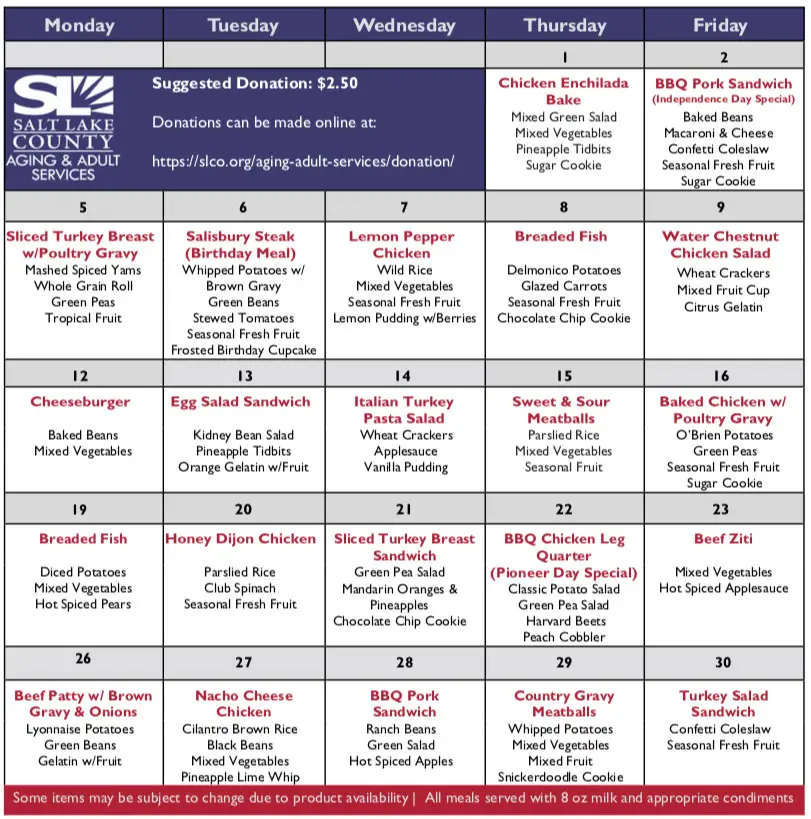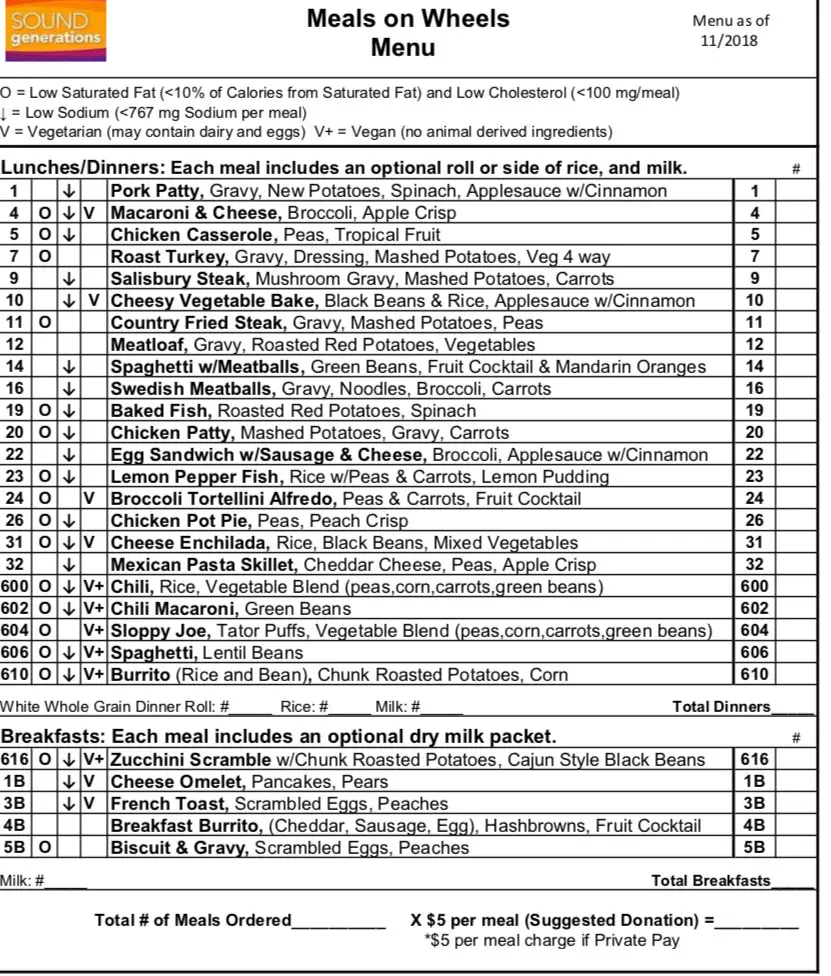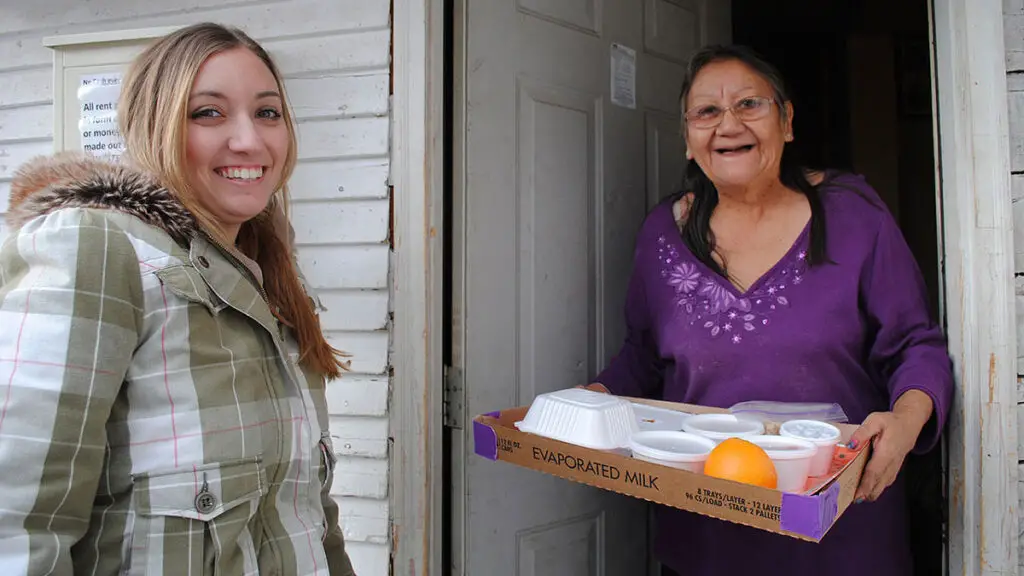
Meals on Wheels are a valuable resource for thousands of seniors all across America who need help paying for or preparing meals on their own. But what about Meals on Wheels menus? Is the food actually good? Is it healthy?
During my time working for an Area Agency on Aging, Meals on Wheels was one of the biggest resources we were able to connect elders with. People were either discharged from a hospital and now found they needed help with meal prep, perhaps a spouse passed away and this changed cooking dynamics, or maybe healthy food was just too expensive. Meals on Wheels helped. More than just helping with food, the delivery of it often offered daily interaction/check-in with elders who were otherwise isolated most of the time.
It’s such a valuable program that we’ve written on it before:
How Much Do Meals on Wheels Cost?
Who Qualifies for Meals on Wheels?
But let’s step back a moment and look at the interesting history of this program…
A Brief History of Meals on Wheels
Meals on Wheels (MOW) originated in the United Kingdom after World War II. At that time, many people were homeless or unable to cook their own food. Women volunteers got together to provide meals for these people. The meals were kept warm by straw bales or old felt hats inside a baby carriage.
The name “Meals on Wheels” was given to the program where meals were brought to servicemen and then expanded to delivering meals mostly to the elderly for a small charge or sometimes free.
A Good Idea Can’t Help But Spread
By 1953, the idea spread to Australia. It took another 10 years for Canada to start the program in Ontario and another 10 years to establish it in East Toronto. In Nova Scotia there are 68 different MOW programs across the province, serving about 3400 meals a week. The service is funded by the municipality and the United Way with nursing homes, hospitals, restaurants and private homes preparing the foods.
The program has wide appeal since many people may go through a time in their life when cooking becomes too difficult. One statistic of clients in Halifax Canada found that in 1996, 57% of the clients had received the meals for less than three months.
The USA Gets Their Own MOW
In 1954, Philadelphia PA launched its program to provide nourishment to meet the dietary needs of homebound seniors prior to MOW getting started.
In America, MOW is called Meals on Wheels Association of America (MOWAA) and is a non-profit organization. Their goal is to better the social, physical, nutritional and economic lives of vulnerable Americans by providing what’s needed to make a difference in their lives. Their vision is to see no senior go hungry.
The program provides meals to seniors at a fraction of the cost of living in a senior facility. The program is said to provide seniors with improved health, security, and independence. Other benefits include opportunities for increased socialization and better quality of life. The goal is to help older adults stay in their own homes and communities rather than nursing homes. Its headquarters are in Arlington, VA.
Some interesting statistics give the parameters of the program’s outreach:
- 218 million meals provided to 2.5 million Americans, 2016
- Annual meal cost: $2,765/person
- MOW AA supports more than 5,000 communities now.
- A 2008 research study on the causes, consequences and future of senior hunger in America found that 11.4% of all seniors were marginally food insecure. Those with limited incomes, under age 70, Hispanics, African-Americans, those who never married, renters and those living in the southern part of the U.S. were more likely to be at-risk for hunger. Over 50% of all seniors at risk of hunger have incomes higher than the poverty level.
Nutritional Standards of MOW
All Meals on Wheels menus are based on a meal pattern. The plan is based on the 2010 Dietary Guidelines which provides at least 33-1/3% of the nutrients needed by older adults with the exception of potassium, vitamin D and vitamin E.
The meal pattern is adequate in the following nutrients: protein, total fat (about 32% of calories with 8% calories as saturated fats), carbohydrates (51% of calories), total dietary fiber, vitamins A, B6, B12, C, B1, B2, B3, folate, vitamin K, calcium, iron, magnesium, phosphorus, zinc, copper, and selenium, according to the Kansas guidelines. Here’s what we found from the Kansas Meals on Wheels Program:
| Food Group | Weekly Average Serving Size per Meal | Frequency |
| Protein | 2.5 ounces of cooked edible portion | Every meal |
| Whole and Enriched Grains | 2 ounce equivalents | Every meal. At least half of grains must be whole grains. |
| Fruit | 2/3 cup (or 1/3 cup if dried) | Every meal |
| Vegetables | 1 cup equivalent | Every meal |
| Dairy | 1 cut fat free or low fat fluid milk or yogurt; or 1.5 ounces natural cheese; or 2 ounces processed cheese | Every meal |
| Fats and Oils | 1 teaspoon soft margarine/vegetable oil; or 1 tablespoon regular salad dressing. This category is met when higher fat, dairy, protein and baked goods are part of the meal. | Every meal |
| Sweets and Added Sugars | 1.5 tablespoons jam/jelly; or 1/2 cup regular gelatin/pudding/ice cream; or fruits with added sugar; or baked desserts | Weekly |
Sample Meals on Wheels Menus
Take a look at some of the sample menus from different parts of the country for the Meals on Wheels Program.
Northeast – Boston
South – Richmond VA
Central – DeKalb Illinois Meals on Wheels
Southwest – Phoenix Meals on Wheels
Northwest – Salt Lake City Meals on Wheels
Northwest – Seattle Meals on Wheels
Are Meals on Wheels Healthy?
Dr. Donna Schwontkowski, a chiropractor with a Bachelor’s and Master’s in Nutrition contributed the following.
Between 1980 and 1982, I had the opportunity to work with the Meals on Wheels Program early in my nutrition career. I loved the time I spent with the seniors at the center, all the volunteers, and the director of the program. It was obvious that we made a difference throughout the whole county.
I also spent years as a dietitian in charge of institutional dietary departments. Back in the early 1980s, I was one of the first in my state to computerize menus to ensure that the elderly residents truly were getting 100% of the RDI each day, no matter what type of diet they were eating.
Now, 40 years later, I can look at the program from a different perspective after being in the nutrition and health field all these years. I’m actually a bit disappointed. The standards for nutrition are still based on the old Food Pyramid when many studies have shown this needs to be seriously updated. Also, there are recommendations in the meal pattern that simply do not fit anymore.
For example, giving margarine or vegetable oil is not something that will help anyone meet their health goals. The margarine blocks the receptor sites for hormones. Vegetable oil unless it’s olive oil will accelerate the production of free radicals in the body; this was something my own nutrition professor warned us about in the 1970s.
There is little if any fresh vegetable salads on these meals, no nuts or seeds, and very little sources of friendly probiotics for gut health. The protein is restricted to 2.5 ounces per meal. Jams and jellies and fruits with added sugar are allowed, when there have been many studies proving that intake of sugars should be extremely low for many reasons.
Whole and enriched grains such as whole wheat is served with every meal even though wheat is a genetically-modified organism, not a food anymore. It’s linked with over 300 different diseases.
Perhaps some of the problem here is that it’s the American Dietetic Standards that hasn’t updated their own standards.
The old ways we used to eat have shown that they were not tied to health. Why we are continuing them and serving them to such a vulnerable population is a mystery to me. What was nutritious back in the 1970s and 1980s is not considered nutritious now.
I was really counting on my sisters in the profession to do a much better job at serving the seniors. They could be served a meal that starts with a homemade appetizer and unprocessed whole grain (not GMO) crackers, a cup of homemade vegetable soup loaded with nutrients, a decent sized 4 ounce serving of protein with two cooked vegetables (one a cruciferous vegetable and one for high fiber) with almonds or pecans on top, a beautiful fruit salad or veggie salad, and a small piece of sugar-free dark chocolate. A meal like this might even be too much for them to eat, but they could stretch it to eat the leftovers later in the day.
Studies prove that eating soup with a meal increases nutritional status yet this information isn’t utilized. You could counter argue and say “Well no one eats soups in the summer”; however, even freshly squeezed vegetable / fruit juices aren’t on the menu for spring/summer.
Nutrition really matters for this crowd, and you have to do everything possible to provide the highest nutrient dense foods. Fried foods and any processed foods do not belong on this menu at all. Yet, everything is geared towards convenience in getting the foods out to the seniors, not placing nutritional standards high enough on the list of priorities.
It’s time we all sat down over a good meal and made some decisions: What’s more important – saying that we fed so many people or saying that we restored the lives of the people? If we eat a meal that is processed, we won’t come up with the right decision!
The MOW programs have expanded a lot to include other services for the seniors over the last 40 years. Now they recognize the role of ethnic foods in certain locations and gear their menus to it. For example, some cities will have traditional Korean or Chinese foods, kosher meals or Hispanic foods.
Others will assist recipients in figuring out how to make critical home repairs and modifications. Many of them have nutrition assessments of each participant of the program. Wellness and safety checks may be provided, crisis intervention, phone pal programs match up a volunteer to a senior, and pet food is provided for the senior’s pets.
Summary
The Meals on Wheels Program will continue to go on for another 50 years. The question is will it ever evolve to a place where it is truly making more than a marginal difference in the health of the elderly? In 2017 President Trump cut funding because there was no data to support real benefits of the program.
Right or wrong, the way to connect seniors to their community while providing real benefits in health is with community eating events and if providing healthy meals, make sure that real health will be the end result from them. This has been proven in the research study models in several cities. Meals on Wheels may have served its purpose, and now new ideas are bringing change to this whole area. Seniors have a lot of good things to look forward to in the near future.
If you or someone you know could benefit from Meals on Wheels, visit our State Resources page to find the contacts nearest you.
Have your own experience (good or bad) with this program? Let us know in the comments section.

